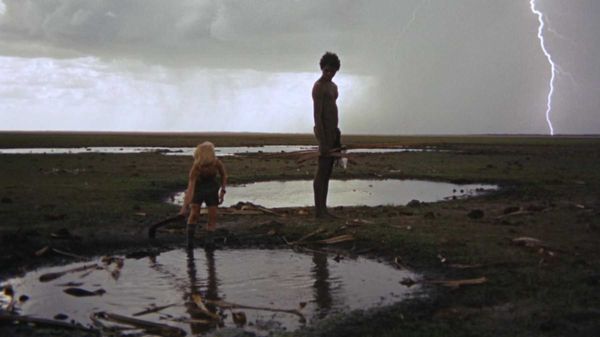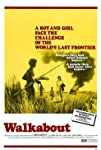Eye For Film >> Movies >> Walkabout (1971) Film Review

There’s a curious bit of text at the beginning of Nicolas Roeg’s Australian epic whose origins nobody seems to be sure about - the director didn’t put there himself. It erroneously describes going walkabout as an Aboriginal right of passage, as opposed to aberrant behaviour by a person forsaking social responsibilities. In either regard, the person whom it most closely applies to in this film is not its young Aboriginal character but the white girl with whom he falls in love.
The girl (Jenny Agutter) is genteel, even prim, acutely aware of herself as part of a civilisation brought from England to the point where she maintains the English accent favoured by Australia’s advantaged classes at the time. Exactly where she comes from is unclear – we see her first in Sydney but later she will talk about walking to Adelaide. Rather than feeling like an error, this contributes to a sense that the action is taking place somewhere separate from the rest of the world, where the usual rules don’t apply, regardless of her efforts to hold onto them. She is a colonial figure adrift in an alien landscape, seemingly helpless, symbolically and perhaps psychically a threat.
She finds herself in the Outback, along with her little brother (credited as Lucien John – actually the director’s son, Luc Roeg), when a shocking event rips them away from the ordinary fabric of their lives. On the pretence of arranging a picnic, their father drives them out into the desert, tries to shoot them and then shoots herself. Though she manages to keep them both safe, they are stranded. Anxious not to let her brother see what has happened, she picks up some supplies and hurriedly escorts him away from the scene – and away from the plume of smoke which might have been their best hope of rescue.
The film is an adaptation of a popular novel attributed to James Vance Marshall (though he almost certainly didn’t write it – its origins, too, are shrouded in mystery). in the book, the children are stranded by a plane crash; here the boy plays with a toy plane. The girl carries a piece of red cloth and the colour red appears throughout the film at significant points, almost absent otherwise, which forms a curious connection to Agutter’s character in The Railway Children, which came out a year earlier but was actually filmed a year afterwards. She also carries the white silk picnic cloth which offers them shelter from the worst of the desert sun whilst suggesting surrender to it. When they rest at an oasis, the boy places a little wind-up plastic rowing boat into the water, but soon he will forsake these emblems of white civilisation for the chance to learn more practical skills.
The opportunity to do so comes with the arrival of the Aboriginal youth (David Gulpilil – then a newcomer). He is moving through the Outback for his own reasons but takes pity on the two obviously incompetent outsiders and decides to travel with them. They have no language in common (the same was true in reality, so Gulpilil improvised his own lines) but he and the boy manage to communicate pretty well through tone and gesture, gradually picking up words from one another.
The girl remains aloof, perhaps representative of an older generation less willing to adapt to its new environment, frustrated with the youth because even when she takes pains to speak extra loudly and clearly, he will not adapt to her. Yet they are both at a certain age, and as they travel, it becomes plain that something else is happening between them. It’s an attraction which seems to be mutual, but which she rejects, again unwilling to compromise. In the film’s epitaph, which sees her apparently married and thoroughly domesticated, she will long for the freedom of that time, but she is willing to sacrifice that freedom in order to hold onto other aspects of her identity and, perhaps, the privilege which whiteness offers her.
All three young performers are on superb form in a film which makes minimal use of dialogue (they do not even get names) and which often leaves them to their own devices, with the camera observing them from a distance. The cinematography is stunning, as one would expect given Roeg’s background, and conveys the vastness of the landscape even as the drama remains small and intimate. Though the youth knows how to read it, the white children are lost in it as if in a dream. Roeg fills that space with life, making the girl in particular seem still more out of place, doing all she can to keep her school uniform neat as she wanders, often without seeing them, amongst snakes, skinks, wombats, kangaroos and birds of a myriad kinds. A particularly fetching echidna gives itself a dust bath. She will brush the dust off before stepping back into a manmade world.
Once seen, impossible to forget, Roeg’s immersive Outback odyssey seems to speak to a world on the brink of destructive change. There’s a sense that the youth recognises this, that his romantic frustrations signify something deeper, an awareness of the tragedy which is people are facing – but in the end, the sense of loss is still bigger than this. It is not only his world which is at stake. The young people’s passage into adulthood parallels a cultural shift which brings with it all sorts of possibilities but also, inevitably, death. Cyclical time gives way to the linear, creating the possibility of an end to all things.
Few films truly deserve to be described as epic. This is one of them.
Reviewed on: 07 Aug 2022














